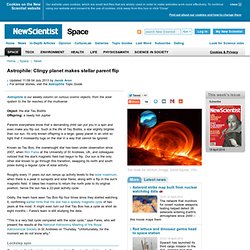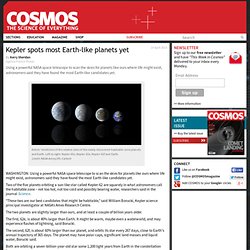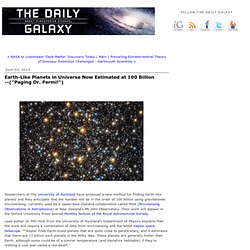

Extrasolar systems. Alien Planets(full documentary)HD. 'Rock Snow' May Fall From Alien Planets' Skies. Eight years ago, astronomers announced the discovery of 51 Pegasi b (51 Peg b), the first planet found circling a sun-like star beyond our solar system.

The planet is about the size of Jupiter, but it orbits far closer to its parent star than Mercury orbits the sun. A year on 51 Peg b lasts just four Earth days. That got Brian Jackson, a researcher at the Carnegie Institution for Science in Washington DC, and colleagues curious if there were planets located even closer to their host stars. So they began sifting through nearly three years of data collected by NASA’s Kepler space telescope. The observatory, now sidelined by a positioning system failure, looked for slight dips in the amount of light coming from target stars, potential telltale signs of planets passing by, or transiting, relative to the telescope’s line of sight.
VIDEO: The Hunt for a Second Earth Surface temperatures on these planets would soar past 3,000 degrees Fahrenheit -- hot enough to melt rock. S Hubble Reveals Rogue Planetary Orbit For Fomalhaut B. NASA's Hubble Reveals Rogue Planetary Orbit For Fomalhaut B › View larger This false-color composite image, taken with the Hubble Space Telescope, reveals the orbital motion of the planet Fomalhaut b.

Exoplanets & Extrasolar Planets, Solar System & Universe Space Exploration. In search of new Earths. TATOOINE, VULCAN, KRYPTON, Arrakis and Gallifrey.

These famous planets of science fiction conjure images of stark frozen deserts, planets of spice and adventure and skies with multiple suns and moons. Dozens of real alien planets are being discovered every month or so and have names like Kepler-36b, CoRoT-7b, KOI-500, PH1 or HD 114762 b. But they are at least as amazing as their fictional counterparts. At the time of publication, we knew of 843 exoplanets (including a planet orbiting one of our nearest stellar neighbours, Alpha Centauri B), with at least 2,300 more suspected candidates. And nobody thinks it will stop there. With a sky lit by not two but four suns, PH1 tops Luke Skywalker’s twin-sunned Tatooine. Astrophile: Snapshot of a two-faced Tatooine world - space - 22 March 2013. Astrophile is our weekly column on curious cosmic objects, from the solar system to the far reaches of the multiverse Object: Massive planet or tiny failed starOrbital partners: A close binary star system Exoplanet hunters may have bagged the first direct picture of a planet with two suns.

But the object, catchily dubbed 2MASS0103(AB)b, has a double life. It is so massive that it may also be a failed star with a relatively tight orbit around the central binary stars. Astronomers have not yet unravelled the truth. Philippe Delorme of the Joseph Fourier University in Grenoble, France, and colleagues took the picture in November last year using a telescope in Chile. Astrophile: Clingy planet makes stellar parent flip - space - 04 July 2013. Astrophile is our weekly column on curious cosmic objects, from the solar system to the far reaches of the multiverse Object: the star Tau BoötisOffspring: a needy hot Jupiter Parents everywhere know that a demanding child can put you in a spin and even make you flip out.

Such is the life of Tau Boötis, a star slightly brighter than our sun. Its only known offspring is a large, gassy planet in an orbit so tight that it incessantly tugs on the star in a way that cannot be ignored. Roughly every 11 years our sun ramps up activity levels to the solar maximum, when there is a peak in sunspots and solar flares, along with a flip in the sun's magnetic field.
Oddly, the team have seen Tau Boo flip four times since they started watching it, confirming earlier hints that the star has a speedy magnetic cycle of two years at the most. Mini planet found far beyond Earth's solar system. Images: Closest-Ever Alien Planet, the Earth-Size Alpha Centauri Bb.
First Planet Discovered in a Quadruple Star System. The planet was first noticed by volunteer citizen scientists studying publicly available Kepler data as part of the Planet Hunters citizen science project.

Crepp says human observers sometimes are more likely than computer algorithms to recognize planets orbiting binary stars because the complex systems do not produce periodic fluctuations like planets orbiting a single star. "We can't see the planet directly, but Kepler can see unambiguous indications that it exists," he says. One of the stars in the binary system is slightly more massive than the sun, one slightly less. They orbit each other once every 20 days, and the planet orbits them once every 137 days.
Crepp's high-contrast image, taken with a telescope in Hawaii, showed a second binary star nearby. For more information: arxiv.org/abs/1210.3612 Journal reference: Astrophysical Journal. Earth-like planets may be closer than thought. WASHINGTON: Scientists looking for habitable planets may not have to stray far from our galactic neighborhood, said a new study, which calculated an Earth-size planet could be orbiting a red dwarf as near as 13 light-years away.

“We thought we would have to search vast distances to find an Earth-like planet. Now we realize another Earth is probably in our own backyard, waiting to be spotted,” said Harvard astronomer and lead author Courtney Dressing. Kepler spots most Earth-like planets yet. Artists’ renditions of the relative sizes of the newly discovered habitable-zone planets and Earth.

Left to right: Kepler-69c, Kepler-62e, Kepler-62f and Earth.Credit: NASA Ames/JPL-Caltech WASHINGTON: Using a powerful NASA space telescope to scan the skies for planets like ours where life might exist, astronomers said they have found the most Earth-like candidates yet. Two of the five planets orbiting a sun-like star called Kepler-62 are squarely in what astronomers call the habitable zone – not too hot, not too cold and possibly bearing water, researchers said in the journal Science. “These two are our best candidates that might be habitable,” said William Borucki, Kepler science principal investigator at NASA’s Ames Research Centre. "100 Billion!" New Kepler Mission 'Rosetta-Stone' Discovery Reveals Planetary Systems as the Cosmic Norm. "I usually try not to call things 'Rosetta stones,' but this is as close to a Rosetta stone as anything I've seen," says John Johnson, assistant professor of planetary astronomy at Caltech.

"It's like unlocking a language that we're trying to understand—the language of planet formation. " One of the fundamental questions regarding the origin of planets is how many of them there are. There's at least 100 billion planets in the galaxy—just our galaxy," says Johnson, coauthor of the study, which was recently accepted for publication in the Astrophysical Journal. Earth-Like Planets in Universe Now Estimated at 100 Billion. Lead author Dr Phil Yock from the University of Auckland's Department of Physics explains that the work will require a combination of data from microlensing and the NASA Kepler space telescope.

*"Kepler finds Earth-sized planets that are quite close to parent stars, and it estimates that there are 17 billion such planets in the Milky Way. These planets are generally hotter than Earth, although some could be of a similar temperature (and therefore habitable) if they're orbiting a cool star called a red dwarf. " "Our proposal is to measure the number of Earth-mass planets orbiting stars at distances typically twice the Sun-Earth distance. Our planets will therefore be cooler than the Earth. Exoplanet House of Horrors. Exoplanet House of Horrors Astronomers may be closer than ever to discovering a planet that’s habitable like our own, but along the way they’ve discovered some very scary exoplanets – places where conditions are far too harsh for life as we know it to exist. We’ve rounded up some of the most frightening, deadly exoplanets, places that make even the scariest haunted house on Earth pale in comparison. Radiation Bath, Anyone? The exoplanets PSR B1257+12 b, c and d were among the first discovered, and also happen to be three of the weirdest.
6 Real Planets That Put Science Fiction to Shame. George Lucas dreamed up planets with two suns and cloud cities, and Gene Roddenberry invented dozens of worlds that were all suspiciously similar to the Southern California desert. But as actual space exploration advances and we start to learn what's really on the surface of those distant worlds, it becomes increasingly clear that our imagination has no chance of competing with the jaw-dropping, pants-peeing craziness outer space is capable of cooking up.
For instance ... #6. Gliese 436 b Is Coated in Burning Ice. The Most Horrific Alien Planets In Our Galaxy: Photos. Loners. Particularly weird loners with unpronounceable names. Carrying an axe. Hitchiking. Yep, that's scary -- a storyline that has been used for generations to scare the pants off cinema-goers. So, what about loner exoplanets? Wandering star brings planet from another galaxy into the Milky Way. These days, the discovery of yet another planet orbiting yet another distant star in our galaxy doesn't seem out of the ordinary.
Unless, of course, the planet and star came from a galaxy far, far away. HIP13044b is the first planet ever detected in the Milky Way that was born outside our galaxy. Thanks to improvements in telescope technology, astronomers have found evidence for almost 500 extrasolar planets in the past 15 years, heavenly bodies of different sizes orbiting distant stars. But all of those confirmed by scientists have originated within the Milky Way. Water Vapor, Carbon Monoxide Found on Extrasolar Gas Giant. A team of astronomers has made the most detailed examination yet of the atmosphere of a Jupiter-size extrasolar planet. Artist’s rendering of the planetary system HR 8799 at an early stage in its evolution, showing the planet HR 8799c, a disk of gas and dust, and interior planets (Dunlap Institute for Astronomy & Astrophysics / Mediafarm) This exoplanet, named HR 8799c, orbits a star known as HR 8799.
According to the study published online in Science Express, HR 8799c has water and carbon monoxide in its atmosphere, but not methane. The team suggests that a particular planet-forming mechanism, known as core accretion, brought the exoplanet, into existence. HR 8799c is a gas giant, with about seven times the mass of Jupiter, and astronomers have been debating whether similar planets form via this core accretion process or by another possible mechanism, known as gravitational instability.
Astronomers Spy Earth-like Planet Forming Around Distant Star. HD Weirdest Planets Doc.mkv. 'Backward' Orbit Of Exoplanet Explained By Discovery Of Extra Planet, Nearby Star. By: Miriam Kramer Published: 01/25/2013 06:45 AM EST on SPACE.com. How the Universe Works (S02E03) Planets From Hell.
Astrophile: Supercritical water world does somersaults - space - 18 November 2011. Astrophile is our weekly column covering curious cosmic objects, from within the solar system to the furthest reaches of the multiverse Object type: Extrasolar planetComposition by mass: 70 per cent rock, 30 per cent supercritical water Orbital angle: Constantly changing. Astronomers Take 1st Look at Clouds of an Alien World. 8 Billion Years Earlier than Earth (Weekend Feature) The Wild Weather of Hot Jupiters. A newly published study and a four minute video from NASA Science explore the wild weather on exoplanets known as hot Jupiters. Brown Dwarf Exoplanet Identified. Super-Jupiter Planet Observed By Astronomers Using the Subaru Telescope - Space News. August 6, 2013 Image Caption: Glowing a dark magenta, the newly discovered exoplanet GJ 504b weighs in with about four times Jupiter's mass, making it the lowest-mass planet ever directly imaged around a star like the sun.